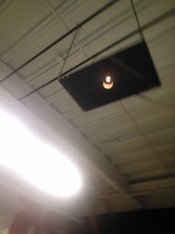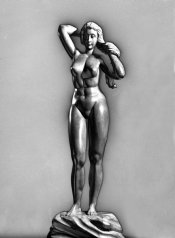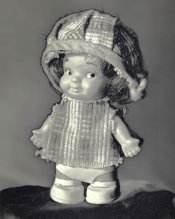



I was asked in a PM by the OP to describe my working method, and rather than do it by PM I would prefer to put it here so those interested can see.
I follow Mr Jolly's formula for film solarization to a tee and am very grateful he wrote such a wonderful article.
pinch sodium sulfite
metol- 144 g
sodium sulfite - 450 g
sodium carbonate - 420g
sodium bromide - 56g
12 litre of water at 120 degree- then bring down to 70 degree for processing
FILM SOLARIZATION
I put all 12 litres of dev in the first stainless steel tank you see which is the farthest from the camera , I load all my film in holders and can do two hangers or 8 sheets at a time.
I use a 5 minute time with a flash half way between, by laying the two hangers on the steel plate between the dev and the fix and turn on the light.
I use a flasher as shown connected to a power unit which can double or triple power .. that is connected to a timer... the flash is always between 2-5 seconds.
I have adapted the flasher unit with current bulbs and have bought enough to last my life...I use Mr16 dichro cool eye bulbs
When doing my work I set up the camera and do four test neg's bracketing on what I think is correct exposure... then go into the darkroom and process, flash and fix.
by doing this each time I shoot objects its like having polaroids .. I look for the exposure that gives me the best maki lines..
Then I load up two exposures slightly different of each object so I always have two versions to choose from .
For the best maki line ( black border) one needs to slightly underexpose so I have found this testing to be a good method .
Calculating the flash time is a bit tricky and I would suggest shooting two or three sets of brackets, then try two or three different runs with different flash density.
Try to keep your time between two and four seconds and get back into the dev and agitate quickly to avoid flow marks.
On a typical day I will load twenty to thirty holders with film and pick objects around the same size and use hot lights only so I can see the lighting, as well I have
found for my work a blue neutral background works best.
I have also found that simple objects with flat surfaces, like rubber duckies work well... Maybe thats why Man Rays nudes look so wicked.
PRINT SOLARIZATION
for this I split the developers into two baths with the flasher over the second developer. To the second developer I add 450 grams of Potassium Bromide
this in my layman language changes the grains structure of the flashed areas of the prints, that when split toned,(I use three toners- sepia, selenium then blue)
will give more grain structure differences thus more colour possibilities.
I use a flash that will create a nice white maki line , lately I have been pulling the print in the second developer to taste, much like lith prints.
The developers are split equally time wise , a tip would be to just have the image emerging well in the first developer, if its too light the effect is way to strong, and if too dark the image will not get maki lines.
I use dodging and burning to my advantage to create areas of real and unreal.
It is very important to agitate well, in both baths as you will get flow marks and use an acid stop bath.
My current paper is Ilford MG4 matt.
It should be obvious to some that if you solarize the neg's then the prints you will get both maki lines and that is the line of approach I am taking now on my current work. Lately I am exposing two subject matters hoping to get 10 decent portfolio images from each group, between shooting,processing and portfolio printing it takes about two months.
Obviously I am a huge fan of Man Ray, and when I started this project which is now called Alchemy of Light , I tried not to mimic his work and for years, never looked at his work as to not be influenced in my own. I believe Man Ray only did film solarizations and not print. I do think Ed Buffalo did a lot of print solarizations.
Every thing Mr Jolly wrote on the subject has proven out to me to be correct, I have been doing this now for about 10 years and its uncanny how correct he was on all aspects of the chemistry, exposure and effect.
I am very open to discussing this fascinating process with any worker willing to give it a go. I enjoy this process more than any work I am doing as it involves a camera and my favourite place the darkroom
BTW I only use 4x5 and 8x10 Ilford FP4
The cameras I use are as follows
110 year old 8x10 studio Camera
4x5 sinar plus sometimes extended bellows for closeups
4x5 graflex modified twin lens pass port camera where I can put two images on one film
8x10 sinar with extended bellows for close up and vertical work.
You can see some of my work patersoncarnie.com or if you are in the Calgary area next month our work is being exhibited at Endeavour Art Gallery during the Exposure photo festival.
Bob









